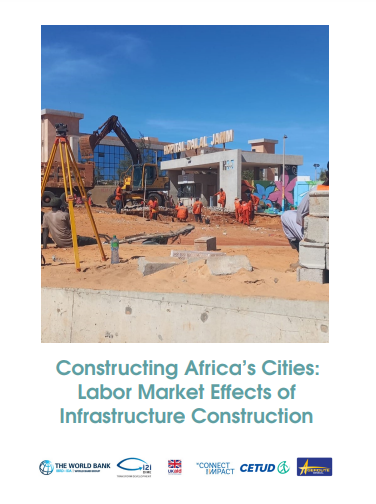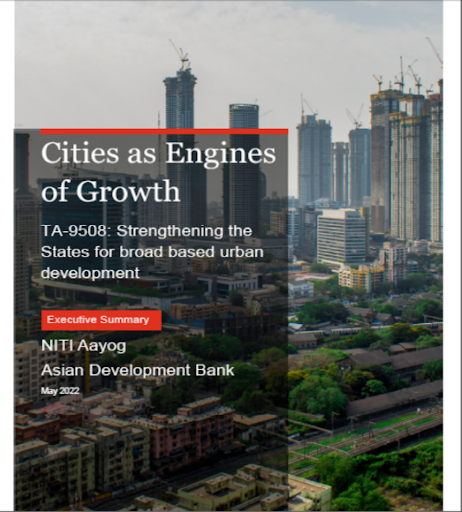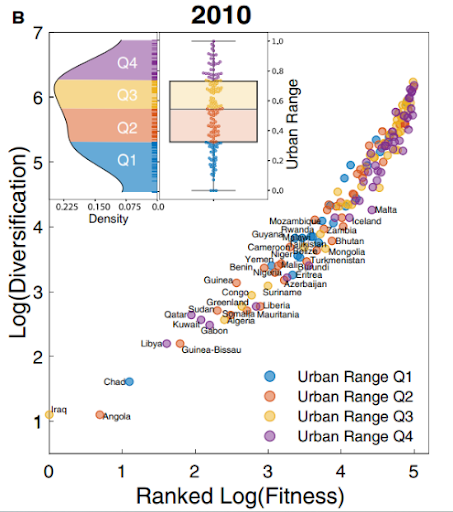
THEME OF THE FORTNIGHT
URBANISATION AND ECONOMIC GROWTH
REPORTS
Constructing Africa’s Cities: Labor Market Effects of Infrastructure Construction

Authors: Sveta Milushev, Sandra Buzinsky, Aram Gassama, Marion Sagot, and Vincent Thorne
Publication Details: World Bank Group, 2024
Africa's fast population growth and urbanisation call for large infrastructure investments, especially in the transportation sector, to handle the growing labour force and enhance mobility.
Launched in 2019 and scheduled for completion in 2024, Dakar, Senegal's Bus Rapid Transit (BRT) project seeks to improve urban mobility while generating job opportunities. With an emphasis on employment trends and worker welfare in low-skilled construction jobs, the World Bank's Development Impact Evaluation (DIME) team conducted this study to evaluate the labour market impact of infrastructure investments. Data on demographics, employment status, and well-being were gathered using a quasi-experimental methodology and a baseline survey, mainly among male applicants between the ages of 18-45. The majority of applicants were young (mean age of 29), had a range of educational backgrounds, and had previous construction experience, according to the findings. With 56% of respondents, primarily in temporary positions paying an average of 35,500 CFA per week, employment conditions were precarious. Life satisfaction was generally low, especially among older unemployed people, even though 50% of respondents said they were satisfied with their jobs. Large infrastructure projects have the potential to generate jobs, according to the study, but to optimize long-term socio-economic benefits, policies that guarantee job stability and skill development are necessary.
Cities as Engines of Growth – Strengthening Urban Development in India

Authors: NITI Aayog and ADB
Publication Details: NITI Aayog and ADB, 2022
India’s rapid urbanisation presents a critical opportunity to drive economic growth, with cities already contributing 60% of the nation’s GDP despite occupying only 3% of its land. To achieve its ambition of a $5 trillion economy by 2026 and $40 trillion by 2047, India must enhance the economic potential of both its large metropolitan areas and smaller cities. However, fragmented governance, inadequate infrastructure, and regulatory challenges prevent many cities from realizing their full capacity as engines of growth. This study, conducted by NITI Aayog and the Asian Development Bank, examines the relationship between urbanisation and economic performance while identifying key constraints and actionable solutions.
The research adopts a four-module approach, beginning with the selection of 12 cities across seven states based on their economic and urbanisation potential. A detailed analysis, supported by more than 130 stakeholder consultations, highlights five major bottlenecks hindering urban growth: lack of integrated economic vision; inefficient land policies; inadequate infrastructure; weak institutional capacity; and regulatory constraints. The findings confirm that larger cities exhibit stronger agglomeration economies, where higher population density correlates with increased productivity, wages, and innovation. To unlock the full potential of urban centres, the study proposes a strategic roadmap focusing on integrated planning, regulatory simplifications, infrastructure enhancements, optimized land use, and affordable housing solutions.
Read More: https://www.niti.gov.in/sites/default/files/2022-05/Mod_CEOG_Executive_Summary_18052022.pdf
Urbanization and Economic Complexity

Authors: Riccardo Di Clemente, Emanuele Strano, and Michael Batty
Publication Details: Scientific Reports, 2021
The report explores the interplay between urbanisation and economic development by analysing global export patterns from 1995 to 2010. Using economic complexity theory, the researchers demonstrate that urbanisation plays a critical role in shaping a nation’s financial structure in its early growth phases. However, this relationship weakens in highly urbanised and resource-dependent economies, indicating that urbanisation alone does not guarantee economic transformation.
Read More: https://www.nature.com/articles/s41598-021-83238-5.pdf
RESEARCH PAPERS
Urbanization, Economic Agglomeration and Economic Growth
Author(s): Yejin Liu, Meirong Yang, Jiahui Cui
Publication Details: Heliyon, 2024
Urbanisation and economic agglomeration are crucial drivers of economic growth, yet their interplay remains a subject of ongoing debate. This study examines the impact of urbanisation on economic growth through the lens of economic agglomeration by employing a spatial econometric model using panel data from twenty-seven Chinese provinces between 2006 and 2020.
The findings confirm that urbanisation positively influences economic growth and that economic agglomeration creates a spatial spill over effect. However, the nature of agglomeration matters: while a single-centre agglomeration model tends to hinder urbanisation and economic progress, a multi-centre model fosters regional development. Furthermore, the influence of urbanisation varies across regions due to differences in geographic location, resource availability, and economic conditions. The study highlights the importance of balanced urban planning and policy interventions to optimise agglomeration benefits and enhance economic growth across different regions.
Read More:https://www.sciencedirect.com/science/article/pii/S2405844023109807
Rethinking Urbanisation and Economic Development: A Synopsis
Author(s): Ivan Turok, Andreas Scheba, and Justin Visagie
Publication Details: Environment & Urbanization, 2023
As the global population becomes increasingly urbanised, with projections indicating that by 2050, two-thirds of people will reside in cities—most of which will experience growth in Asia and Africa—the relationship between urbanisation and economic development has never been more critical. This paper examines the theory of agglomeration economies and their impact on urbanisation in advanced economies of the Global North, drawing key parallels to select economies in the Global South to show how urbanisation led to a steady rise in prosperity.
The analysis covers five essential dimensions of the urbanisation-development connection: the dynamics of agglomeration forces and their scope; the role of the wider economic environment in shaping urban economies and the opportunities for cities in the Global South to integrate into global value chains through the development of tradable goods and services; the diverse population trajectories of Southern cities, encompassing rural-urban migration and natural growth; the intricate relationship between urban form, economic growth, and informal sectors; and the governance structures of urbanisation are explored, emphasising the challenges and potentials of local governments in addressing informality and planning for sustainable, equitable urban growth.
Read More https://journals.sagepub.com/doi/10.1177/09562478231193829?icid=int.sj-full-text.citing-articles.9
Causality Between Urbanization and Economic Growth: Evidence from the Indian States
Authors: Abdul Shaban, Karima Kourtit, Peter Nijkam
Publication Details: Frontiers (online research article), 2022
The relationship between urbanisation and economic growth in India has long been debated, with differing views on whether cities drive economic expansion or if rising incomes lead to greater urbanisation. While conventional theories suggest that urban centres act as engines of growth by fostering economies of scale, innovation, and labour productivity, alternative perspectives argue that economic growth itself fuels urbanisation, especially in regions with weak infrastructure and social overhead capital. To explore this dynamic, a comprehensive analysis of long-term data from 1971 to 2020 across 15 major Indian states has been conducted. The study examines shifts in urban and economic trends before and after India’s 1992 economic liberalization, offering deeper insights into how market forces and policy changes have influenced urbanisation patterns over time.
The findings challenge the traditional view that urbanisation directly stimulates economic growth. Instead, the results indicate a unidirectional causality from economic growth to urbanisation in most Indian states, implying that rising incomes, rather than urban expansion itself, drive rural-to-urban migration. Among economic sectors, the tertiary sector (services) emerges as the primary driver of urbanisation, while the primary (agriculture) and secondary (manufacturing) sectors play a less significant role.
The paper's findings suggest that the unequal development of urban and rural areas compels people to migrate in search of better infrastructure, education, healthcare, and employment opportunities. The study calls for a more balanced approach to urban and rural development, advocating for strategic investments in rural infrastructure and services to reduce excessive urban migration pressures and promote more inclusive and sustainable economic growth across regions.
Read More: https://www.frontiersin.org/journals/sustainable- cities/articles/10.3389/frsc.2022.901346/full
Correlation between Urbanization and Economic Development
Authors: Bibek Debroy, Amit Kapoor & Aditya Sinha
Publication Details: BW BUSINESSWORLD, January 2021
This article explores the correlation between urbanisation and economic growth, analysing global trends and specific cases, including India. While higher urbanisation levels are often associated with increased GDP per capita, the relationship is not always straightforward. The study highlights how industrialisation, colonial history, and policy decisions shape urban growth patterns, leading to disparities in economic benefits.
The authors emphasise that urbanisation alone does not guarantee economic prosperity. Migration-driven urbanisation tends to spur growth more effectively than natural urban expansion, as it fosters labour mobility and remittance-driven rural development. However, administrative reclassification of rural areas into urban centres does not necessarily translate into higher productivity. The paper underscores the role of economies of scale in urban areas, where efficient infrastructure investment can enhance economic output.
Conversely, unchecked urban expansion can lead to diseconomies—such as inadequate sanitation, housing shortages, and infrastructural deficits—hampering economic progress. The study argues that while urbanisation presents immense opportunities, its benefits depend on the creation of an enabling sustainable, economic and inclusive environment rather than mere demographic shifts.
Relational Patterns of Urbanisation and Economic Growth in Sub-Saharan Africa
Author(s): Joseph Onjala, Owiti A. K'Akumu
Publication Details: Development Southern Africa, 2016
In the developed world, economic growth can largely be attributed to the transition from a rural agricultural economy to an industrial and service-based economy. However, this pattern has not necessarily held in developing countries. In many regions, urbanisation has occurred without corresponding economic growth, making it crucial to examine the specific patterns of urbanisation in Sub-Saharan Africa (SSA), which remains one of the poorest and slowest-growing regions globally. This study seeks to analyse the relationship between economic growth and urbanisation across SSA countries by charting their gross domestic product (GDP) growth rates against urbanisation growth rates from 1982 to 2012 and further comparing these countries to emerging and developed economies.
The analysis identified two primary patterns: countries where GDP growth is closely linked to urbanisation, and countries where no such relationship exists. The study reveals that in countries like Botswana, Uganda, Sudan, Zambia, the Democratic Republic of Congo, Mozambique, Ethiopia, South Africa, and Namibia, economic growth and urbanisation are happening simultaneously, contrary to traditional assumptions. In contrast, in much of SSA, urbanisation is taking place without the benefits of economic growth, leading to widespread urban poverty.
Read More: https://www.tandfonline.com/doi/full/10.1080/0376835X.2015.1120655#abstract
National Institute of Urban Affairs
1st Floor, Core 4B, India Habitat Centre, Lodhi Road, New Delhi -110003, India
Telephone: (011) 24634971, 24643576
Email: director@niua.org • Website: niua.in





